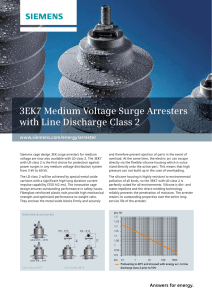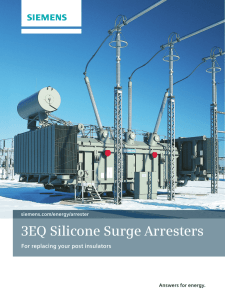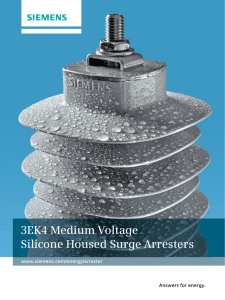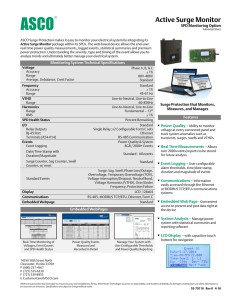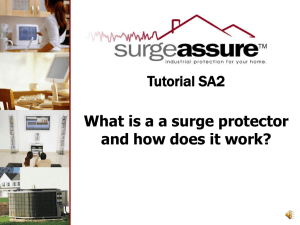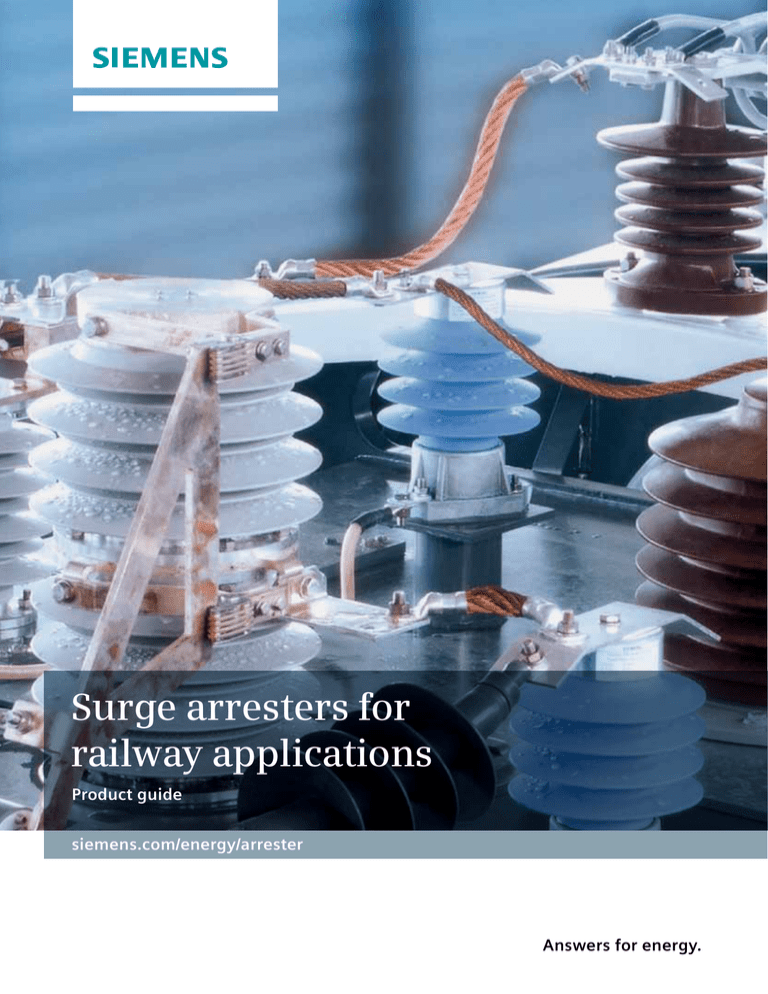
Surge arresters for
railway applications
Product guide
siemens.com/energy/arrester
Answers for energy.
Definition of surge arresters
Surge arresters are used to protect electrical equipment, such as transfor­mers and circuit breakers, in
substations and in rail systems against the effects of overvoltages caused by incoming surges. Such
overvoltages can be caused by a direct or nearby lightning strike, an electromagnetic pulse, electrostatic
discharge, or switching operations in the power supply system as well as in devices. Some overvoltages are
very high in energy. The current from the surge is diverted through the arrester, in most cases to earth.
Effective overvoltage protection requires that different surge arrester types be used according to the
particular application.
2
Contents
Definition of surge arresters
02
Siemens surge arresters for any requirement
04
Always the best solution for traction systems and for rail electrification
05
History timeline
06
Supply voltages of traction systems
08
The best choice for every application
09
Silicone rubber
10
Surge arresters for rail applications
11
3EB1 and 3EB4 silicone rubber surge arresters with composite hollow core design
12
3EL2 silicone rubber surge arresters with Cage Design™
14
3EC3 porcelain surge arresters for rail applications
16
3EB2 and 3EB3 surge arresters for A1 and A2 application
17
Standards and testing – reliability you can count on
18
Product range
19
Dimensions, terminals, and mounting
22
3
Siemens surge arresters for any
requirement in railway applications
Experience is most essential when it comes to reliability in
medium- and high-voltage applications. Siemens has been
designing and manufacturing medium- and high-voltage
surge arresters for standard and special applications since
1925. Continuous research and development, the wealth
of Siemens’ know-how, and comprehensive worldwide
experience give Siemens surge arresters a leading edge in
overvoltage protection. Their uncompromising quality
ensures a long service life and reliability in any application.
Siemens surge arresters are an indispensable aid to
insulation coordination in electrical power supply systems.
Valuable equipment such as transformers, circuit breakers,
generators, motors, capacitors, traction vehicles, and
bushings, as well as complete switchgear, is ideally
protected against lightning and switching overvoltages.
Siemens surge arresters have been designed to meet the
requirements of a wide range of common installation
environments, from arctic cold to the heat of the desert
and the humidity of tropical climates. They are available
for any application from 300 V up to 1200 kV – including
overvoltage protection of electrified railway systems.
Siemens surge arresters protect every part of a railway
system, from traction substations, transmission lines,
cables, and catenary systems to rail vehicles for local,
long distance, and high speed services.
World-famous protection
Siemens surge arresters ensure cuttingedge overvoltage protection in railway
systems applications all over the world.
4
Always the best solution for traction
systems and for rail electrification
Electrical power for traction systems is generally
transmitted to traction substations of the (national) utility
or the railway systems’ own high-voltage network by high
voltage transmission lines of nominal voltages of 110 kV
and above with frequencies of 16 2/3 Hz, 25 Hz, 50 Hz, or
60 Hz. The voltage is then stepped down to the supply
voltage of the traction system and converted into DC
voltage if necessary. The high-voltage transmission lines,
the traction substations, the catenary system, and the
traction vehicles are exposed to lightning overvoltages
that may result in huge damage to the electrical
equipment’s insulation.
That’s why overvoltage protection of the transformers
within the substations, the points of supply of the
catenary system, and the traction vehicles has always
been necessary. Apart from this main task, the increasing
use of electronic devices in railway applications demands
reliable protection against any overvoltage – a challenge
that modern surge arresters can additionally solve.
More than 80 years of experience in the development
and manufacture of surge arresters for rail applications
gives Siemens overvoltage protection products a leading
position on the market. Excellent reliability has always
been the outstanding feature of all products. Developments
in technology and practical experience have led to several
types of surge arresters that are ideally suited for rail
systems and for rail electrification purposes:
• 3EB1 – silicone rubber surge arrester with composite
hollow core design for use on traction vehicles in AC
and DC systems.
• 3
EB4 – silicone rubber surge arrester with composite
hollow core design for use on traction vehicles and for
fixed installation in AC and DC systems.
• 3
EB2 – A surge arrester with silicone housing for fixed
installation in DC systems; for A1 and A2 application,
DC-B classification.
• 3EB3 – A surge arrester with silicone housing for use
on traction vehicles and for fixed installation in DC
systems; for A1 and A2 application, DC-C classification.
• 3EC3 – porcelain surge arrester for use on traction
vehicles and for fixed installation in DC systems.
• 3EL2 – silicone rubber surge arrester with Cage
Design™ for use on traction vehicles and fixed
installation in AC systems.
Siemens provides each of these types in several versions,
making it possible to find the ideal surge arrester for any
conceivable application and meet even specific demands,
such as:
• h
igh mechanical stability to withstand vibrations and
high wind speeds,
• e
xtremely reliable pressure relief behavior for use in
areas requiring special protection,
• e
xcellent pollution layer characteristics for use in
coastal and desert regions or in areas with extreme air
pollution.
All Siemens surge arresters feature a superior sealing
system that reliably prevents moisture ingress to ensure
the highest possible degree of overvoltage protection and
decades of trouble-free service. Moreover, the choice of
materials used in the making of Siemens surge arresters
contributes to the protection of the environment.
5
1925
1971
1989
Siemens begins developing
surge arresters. The first
devices are of the so-called
cathode drop type.
Development
of the first gasinsulated and
metal-encapsulated surge arrester
for gas-insulated
switchgear (GIS).
The 3EQ2 surge arrester for
systems of up to 550 kV is one
of the first high-voltage surge
arresters with composite polymer hollow core housing.
1847
1934
The ten-employee company
Telegraphen-Bauanstalt
von Siemens & Halske
(Telegraph Construction
Company of Siemens &
Halske) begins operation
on October 12, 1847, in
a back building in Berlin.
The first surge
arrester for railway
applications is
launched.
1995
The 3EB1 surge arrester
for rail applications has
been especially designed
for the ICE 2, the highspeed train of the German
Railways.
1900
1866
Werner von Siemens discovers the dynamo-electric
principle, which enables
electricity to be put to practical use. The dynamo can
convert mechanical energy
into electrical energy in an
economical way. Its invention lays the foundation for
today’s world of electrical
engineering.
1963
1992
The first surge arrester for
systems of up to 550 kV is
launched. The pulley wheel
electrodes are replaced by
ceramic-bonded shunt
resistors and a series spark
gap. The surge arrester
comprises three columns in
parallel and has a resistivecapacitive control.
Continually pushing the
envelope, Siemens develops a high-voltage surge
arrester with a composite
polymer housing for systems of up to 800 kV. It
was originally developed
as a suspended mounted
HVDC valve arrester with
several parallel metal oxide
columns in a common
housing.
1982
Siemens’ first gapless metal
oxide arrester, a GIS surge
arrester, is delivered for the
123 kV grid in Inchicore, a
suburb of Dublin.
History timeline
Siemens is a pioneer in many fields of the electricity and digitization markets. Experience is most essential
when it comes to reliability in medium- and high-voltage applications. Since 1925 Siemens has been manufacturing high-voltage surge arresters up to rated voltages of 1,200 kV – for standard and specialized applications. Permanent research and development and the concerted know-how in the factories give Siemens surge
arresters a leading edge in overvoltage protection. Uncompromising quality ensures a long service life and
reliability in any application.
6
1998
The polymer-housed medium-voltage/distribution
class arresters of the 3EK
family, which features Cage
Design™, a unique solution
with direct silicone molding
on the metal oxide varistors, is introduced.
2003
Completion of the first line
arrester project, an order
from KELAG, one of the
leading energy service
providers in Austria.
2007
2011
2014
3EL2, the first line
arrester for 550 kV
applications, is
delivered to Sochi,
a city in Russia.
Siemens introduces
its new range of
long rod insulators.
The 3EB4, based
on hollow core design, is introduced
for use with high
travel speeds.
2000
2010
2006
2008
2010
Development of the 3EQ5,
a new surge arrester concept
with composite housing
(type A) for extra highvoltage applications in
800 kV DC and 1,200 kV AC
transmission systems.
The first externally gapped
line arrester (EGLA), which
increases the reliability of
a 144 kV overhead line, is
supplied to the South Korean power provider KEPCO.
The world’s first 1,200 kV
substation arrester with
composite polymer hollow
core technology is delivered to Power Grid Corporation of India.
2010
2000
Development of the first
GIS arrester for systems of
up to 800 kV.
Siemens launches the
arrester condition monitor,
an innovative monitoring
solution with unique features.
As a pioneer in the field of silicone rubber insulation and one of the few suppliers with comprehensive inhouse research and development capabilities in this technology, Siemens has been providing surge arresters with silicone rubber housing for more than 30 years and has gathered excellent service experience from
even the most severe climatic and environmental conditions. Today, silicone rubber is among the most
widely used materials for high-voltage outdoor equipment.
7
Supply voltages
of traction systems
The main task of an arrester is to protect equipment from
the effects of overvoltages. During normal operation, an
arrester should have no negative effect on the power
system. Moreover, the arrester must be able to withstand
typical surges without incurring any damage. Nonlinear
resistors fulfill these requirements thanks to the following
properties:
• L ow resistance during surges, so that overvoltages are
limited
• H
igh resistance during normal operation to avoid
negative effects on the power system
• S
ufficient energy absorption capability for stable
operation
With this kind of nonlinear resistor, there is only a small
flow of current when continuous operating voltage is
being applied. When there are surges, however, excess
energy can quickly be removed from the power system by
a high discharge current.
Nonlinear resistors made of metal oxide (MO) have proven
especially suitable for this use. The nonlinearity of MO
resistors is considerably high, which is why MO arresters
do not need series gaps. Siemens has many years of
experience with gapless MO arresters in low-voltage
systems, distribution systems, and transmission systems.
Siemens metal oxide varistors (MOVs) provide a high
energy absorption capability and a very low protection
level. This means they absorb a high amount of energy
while avoiding thermal runaways. Siemens surge arresters
are less prone to self-heating and consequent selfdestruction, and they maintain their characteristics
throughout their lifetime.
Supply voltages for railway power supply systems
Supply voltages of railway power supply systems are defined
in the DIN EN 50163 standard (VDE 0115 part 102). The
terms and definitions used there include the following:
Nominal Voltage Un
Design value for system equipment
Maximum continuous voltage Umax1
Maximum value of the voltage that can occur indefinitely
Maximum nonpermanent voltage Umax2
Maximum value of the voltage that can occur as a nonpermanent voltage (applies for long duration transition
states)
Highest long-term overvoltage Umax3
R. m. s. value of an AC voltage as a maximum value of the
long-term overvoltage for T = 20 ms
Long-term overvoltage
Overvoltage > Umax2 and > 20 ms, (e.g., due to a rise in
substation primary voltage)
Continuous operating voltage
Uc ≥ Umax2
Typical nominal and continuous
operating voltages
Nominal voltage
750 V
1,500 V
3,000 V
15,000 V
25,000 V
Umax1 (V)
900
1,800
3,600
17,250
27,500
Umax2 (V)
1,000
1,950
3,900
18,000
29,000
Umax3 (V)
1,270
2,540
5,075
25,300
38,750
Uc (V)
1,000
2,000
4,000
18,000
29,000
Ur (V)
1,000
2,000
4,000
23,000
37,000
Voltage [V]
3,000
Umax Arrester
Umax System
Un = 1,500 V
2,500
2,000
1,500
1,000
0.01
8
0.1
1
10
100
1,000 Time [s]
The best choice
for every application
Whether it is high-speed, intercity trains between the major
cities of the world, train shuttle services from train stations
to airports that run every few minutes, or everyday mass
transit, the requirements of rail transport vary from one
extreme to the other.
Siemens supplies a complete portfolio of surge arresters
that meets all worldwide requirements for the overvoltage
protection of rail vehicles and rail electrification. Apart from
the system voltage, the main criterion for the selection of an
appropriate surge arrester is the type of application, which
defines traveling speed and resulting load.
With their insulator sheds designed for extreme mechanic
loads, the silicone-housed surge arresters 3EB1 and 3EB4
are outstandingly well suited for high travel speeds. Both
surge arresters have extremely rugged housings and a
directional pressure relief device offering maximum security
in areas accessible to the public.
The porcelain-housed 3EC3 is particularly suitable for use
on traction vehicles and for stationary applications in DC
systems, such as medium voltage DC switchgear, while
3EB2 and 3EB3 silicone-housed surge arresters have been
specially designed for overvoltage protection in DC systems
in accordance with the VDV A1 – A2 application. The 3EB2
is a DC-B-classified surge arrester; the 3EB3 is DC-C
classified and offers increased discharge capabilities.
The silicone-housed Cage Design™ surge arrester 3EL2 is
mainly applied in typical medium- and high-voltage
applications, such as substations, but it is also very well
suited for the overvoltage protection of rail vehicles and
for rail electrification.
For the overvoltage protection of substations in rail
electrification, Siemens also offers its complete portfolio
of proven medium- and high-voltage surge arresters for
AC networks and substations.
The »selection table per application« provides an overview
of all surge arresters and their applicability for the various
fields of application.
An overview of typical power systems for railway
applications and the applicability of the various surge
arresters per voltage level is provided by the table »Typical
rail power systems.«
For additional specifications, please contact your local
Siemens representative.
Selection table per application
Rail application
3EB1
AC
Traction vehicles
High-speed and intercity trains
3EB4
DC
1
AC
DC
3EB2
3EB3
3EC3
3EL2
DC
DC
DC
AC
1
Commuter and regional trains
Urban transport: Light rail, metros, streetcars, eBus
(Multi-system) locomotives
1
Propulsion systems
Rail electrification
Power supply for catenary system
Substation2
Surge arrester for A1 and A2 application
1
2
Multi-system traction vehicles
Please refer to the product guide »High-voltage surge arresters« for a complete overview of surge arresters for the overvoltage protection
of substations
Typical rail power systems
Power system
AC
3EB1
3EB4
3EB2
3EB3
3EC3
3EL2
12.5 kV, 25 Hz / 60 Hz
15 kV, 16 2/3 Hz
25 kV, 50 Hz / 60 Hz
DC
1
750 V
1
1500 V
1
3000 V
1
Multi-system traction vehicles
9
Silicone rubber
As a pioneer in the field of silicone rubber
insulation and one of the few suppliers
with comprehensive in-house research
and development capabilities in this
technology, Siemens has been providing
surge arresters with silicone rubber
housing for more than 25 years and has
gathered excellent service experience
from even the most severe climatic and
environmental conditions. Today, silicone
rubber is among the most widely used
materials for high-voltage outdoor
equipment.
Siemens silicone rubber-housed surge
arresters are polymer-housed arresters
that use silicone rubber as the only
insulating material. The exclusive use of
silicone has proven to be the best solution
in several studies: Silicone rubber is
highly hydrophobic. While there are many
polymeric materials with similar initial
hydrophobic properties, most of them,
such as EPDM alloy rubber, lose their
hydrophobicity after a relatively short
period. Only genuine silicone rubber as
used by Siemens is capable of maintaining
its hydrophobicity throughout its entire
lifetime. This ensures the long service life
of Siemens surge arresters with silicone
rubber housing. Even the most severe
ambient conditions, such as salt fog in
coastal regions or dust-laden air causing
serious contamination in an industrial
area, cannot impair the hydrophobicity of
silicone rubber. This material property
reliably prevents conductive moisture
from forming on the arrester surface,
thus averting surface currents and discharges. Moreover, genuine silicone is
highly fire-retardant and self-extinguishing, and it is neither subject to
erosion nor sensitive to UV radiation.
This ensures the long-term stability of
the housing material.
There are several characteristics that set
the silicone elastomers used by Siemens
apart from other organic insulating
materials.
10
As a matter of principle, Siemens only uses
HTV (high-temperature vulcanized) or LSR
(liquid silicone rubber) silicone elastomers.
These types of silicone help maintain the
properties mentioned above.
Characteristic damage to
EPDM insulators due to
natural UV radiation
Chalking
The –Si–O– backbone of silicone rubber
has a higher bonding energy than the
–C–C– backbone of EPDM. Silicone
rubber has a lower carbon proportion
than EPDM. Consequently, silicone rubber
boasts inherently better chemical and
physical resistance, better UV resistance,
and lower flammability than EPDM.
Consider these facts:
• S
ilicone rubber is highly stable under
the influence of ultraviolet radiation
(sunlight), ozone, and nitrogen oxide.
Its stability beats that of EPDM-based
alloy rubbers.
• T
he hydrophobic performance of a
silicone rubber surface remains
excellent throughout the entire
arrester service life, whereas EPDMbased alloy rubbers lack this critical
requirement.
Cracking
• T
he hydrophobicity of silicone rubber
returns after a corona discharge,
which assures reliable long-term
performance.
• T
he arcing resistance of silicone
rubber is higher as compared to EPDMbased alloy rubbers.
• T
he flame-retardant properties of
silicone rubber comply with IEC 60707
and UL94 V-0 (i.e. self-extinguishing, no
burning drips, probe does not burn).
Moisture
• S
ilicone rubber is resistant to all
common organic and nonorganic
cleaning agents and solvents.
• S
ilicone rubber performs well in an
ambient temperature range of –60 °C
to +200 °C. No other polymeric
material can beat silicone rubber.
Hydrophobic effect on Siemens
silicone rubber surge arrester due
to alignment of methyl groups in
silicone polymers.
Surge arresters
for rail applications
Siemens provides four surge arrester product families
for AC and DC rail applications from 300 V up to 45 kV.
They are described in this brochure:
• 3
EB1 and 3EB4 silicone rubber surge arresters
with composite hollow core design
• 3
EL2 silicone rubber surge arresters
with Cage Design™
• 3EC3 porcelain surge arresters for rail applications
• 3EB2 and 3EB3 surge arresters for
A1 and A2 applications
11
3EB1 and 3EB4 silicone
rubber surge arresters with
composite hollow core design
Design features
Arcing horn
Silicone rubber sheds
directly molded on
FRP tube
Metal oxide blocks
FRP tube
Directional
pressure relief
device
Reliable and safe –
railway surge arresters
3EB1 and 3EB4
3EB1 and 3EB4 type railway surge
arresters have to withstand a lot:
exposure to weather extremes,
temperatures from –40 °C to +70 °C,
and the effects of UV radiation and
hydrophobicity. But that’s exactly what
they were designed for, and they were
effectively protected with suitably
resilient technology and durable
materials to ensure problem-free
operation under all conditions of use.
Siemens supplies two different composite
hollow core silicone-housed surge arresters
for railway applications, specially tailored
to the feeding voltages of railway power
supply systems. In terms of materials and
geometry, the housing is specially
developed to meet the particular use on
traction vehicles.
12
End fitting with
directional pressure
relief device and
sealing system
• 3
EB1 railway surge arresters for speeds
of up to 360 km/h (225 mph).
• 3
EB4 railway surge arresters for speeds
of up to 320 km/h (200 mph) and for
stationary application in areas accessible to the public.
Both arrester types are comparable in
terms of their electrical specifications,
dimensions, and connections.
Siemens’ innovative composite hollow
core design uses silicone and a fiberglassreinforced plastic (FRP) tube as housing
materials. The advantages of this design
are more than compelling, as it offers the
perfect combination of cost savings and
safety for rail systems. The direct molding
of the silicone rubber onto the FRP tube
ensures reliability, while an excellent
special sealing of the flanges at both
ends of the surge arrester effectively
prevents partial discharges and moisture
ingress. The combination of silicone
rubber and FRP tube also allows an
enormous withstand capability against
mechanical forces.
The composite hollow core design
provides a very high degree of safety: In
the case of an overload or the extremely
rare case of an arrester short circuit, the
arc escapes directly through a directional
pressure relief device. The surge arrester,
therefore, can be pointed in a direction
that will minimize the risk of any damage
to the equipment and passengers nearby.
Internal parts are not ejected and the
shatterproof housing does not break.
A reliable, sturdy, and
economic choice
Siemens 3EB1 and 3EB4 composite
hollow core design surge arresters are
virtually indestructible during
transportation, installation, storms, and
vandalism. While the composite hollow
core design provides the highest possible
mechanical strength, the silicone rubber
insulation is ideal for outdoor applications
in severe environmental conditions. No
matter how tough environmental and
operating conditions may be, 3EB1 and
3EB4 arresters assure 100% reliable
pressure relief performance and provide
the ultimate in protection.
Longevity and reliability
Horizontal cut of a composite
hollow core design arrester
The silicone rubber housings of 3EB1 and
3EB4 surge arresters provide the best
possible long life performance for highvoltage surge arresters. They make use of
all the advantages of vulcanizing silicone
rubber sheds onto an FRP tube, providing
enhanced safety and meeting every
requirement.
13
3EL2 silicone rubber surge
arresters with Cage Design™
Design features
Cage of FRP rods
End fittings
Metal oxide blocks
Silicone rubber sheds
directly molded on
metal oxide blocks
and on end fittings
Siemens’ Cage Design ensures high
mechanical strength and safe overload
performance. It is characterized by the
use of silicone and fiberglass-reinforced
plastic (FRP) rods as housing materials.
Reliability is guaranteed by the direct
molding of the silicone rubber onto the
MO blocks and the FRP rods. This ensures
the total embedding of all components
free of enclosures and gaps, thus
preventing any partial discharge or
moisture ingress.
The MO blocks of 3EL surge arresters are
enclosed by a cage made of FRP rods,
which leads to a rigid, reinforced
structure ensuring high mechanical
strength. The high tensile strength of
14
the FRP rods is used to hold the arrester’s
MO blocks in place tightly. This is why
Cage Design arresters are among the
mechanically strongest polymer arresters
available on the market and at the same
time ensure minimal use of material and
very low weight. As the MO blocks are
neither enclosed in a sealed mechanical
shell nor wrapped in hard material, no
excess pressure will develop in the case
of an overload or the extremely rare
event of an arrester short circuit. The arc
can escape directly through the soft
silicone housing, and the ejection of
internal parts that could damage other
equipment nearby is prevented almost
completely.
Long service life
Mechanically strong enough to meet
common mechanical requirements
and with sheds that are resistant to
damage resulting from transport,
installation, storms, and vandalism,
3EL surge arresters are perfectly suited
for in­stallations that demand low weight
and indestructibility of the arrester.
Horizontal cut of a Cage Design
arrester
15
3EC3 porcelain surge
arresters for
rail applications
3EC3 surge arresters can be used for
overvoltage protection in stationary
applications and on traction vehicles in
DC supply systems. Their outstanding
resistance to environmental effects
benefits the reliability of the system and
equipment to be protected as well as the
service life of the surge arrester itself.
Overvoltage protection of the
catenary by 3EC3 surge arresters
The arrester is designed for traction
system applications even in severe
environments, such as coastal areas or
aggressive industrial atmospheres, and
features a sealing material resistant to
NOx, ultraviolet light, and ozone.
Users substantially benefit from various
features that prolong the surge arrester’s
service life and a lower than average
failure rate. The operating record of the
3EC3 surge arresters proves their aboveaverage reliability. Resistance to corrosion,
sealing tightness, and electrical behavior
16
in the system are fully satisfactory even
after many service years. The excellent
sealing system prevents failures or
moisture ingress and guarantees decades
of trouble-free service.
3EC3 surge arresters ensure maximum
protection in an overload situation thanks
to a specially designed directional
pressure relief device. In the case of an
overload or the extremely rare case of an
arrester short circuit, the arc escapes
easily through the pressure relief device.
No pressure is built up inside the arrester
and no internal parts are ejected, which
prevents damage to surrounding
equipment.
3EB2 and 3EB3 surge arresters
for A1 and A2 applications
Recommendation for applications in DC systems according to VDV 52
In its publication No. 525, The »Verband deutscher
Verkehrsunternehmen (VDV)« (Association of German
Transportation Companies) provides operators of DC
railways with recommendations for effective overvoltage
protection in case of lightning strikes. The grounding of the
power distribution system is especially important in the
planning of lightning protection concepts. If the rails of DC
railway systems are isolated from earth for the purpose of
reducing stray current corrosion (as required when laying
new rails), they cannot be used as earth terminations. In
this case, low-resistance tower footings, driven piles, the
reinforcements of reinforced concrete tracks, or separate
earth rods must be used as earth terminations. However,
rails laid without any additional isolation measures generally
only have a low leakage resistance and can be used as earth
terminations. The surge current will then be discharged
through the rails but will endanger electrical and electronic
equipment near or on the tracks. Additional surge arresters
within such equipment provide an effective remedy against
overvoltages caused by this process.
To provide full protection for the catenary, outdoor surge
arresters with VDV 525 designation »A1« should be installed
at every power feeding point, at the ends of feeding
sections and dead-end feeders, at coupling points, and
at current taps. Additional A1 surge arresters are
recommended if sections are hit by lightning strikes very
often, such as on bridges or on open stretches.
Protecting supply and return lines at substations with surge
arresters is an essential element of a lightning protection
concept in railway power supply systems. Two surge
arresters of different ratings are used for this purpose:
• T
ype A1 surge arresters are connected between section
circuit breakers/cable terminals and the return line.
• T
he unavoidable potential rise in a return line caused
by a lightning surge current is limited by a type A2
surge arrester between return line and structure earth.
Although metal oxide surge arresters are exceptionally
reliable devices, with failure rates of well below 0.1 percent
per year, a failure may occur under unfavorable circumstances, which in this case leads to a state of permanent
conductivity of the type A1 surge arrester. If the rails have a
small leakage per unit length, the ground electrode in this
case may receive an inadmissibly high fault voltage for a
long time. However, if an additional A2 surge arrester with a
low continuous operating voltage (120 V ≤ Uc ≤ 300 V) is
connected be­­tween ground electrode and return line, this
surge arrester is intentionally overloaded. This limits the
fault voltage and trips the section circuit breaker due to
feeding from the catenary system.
17
Standards and testing –
reliability you can count on
Tests
Standardization
Siemens surge arresters for rail applications have been
designed and tested in compliance with the latest IEC
60099-4 (AC arresters), DIN EN 50526-1 (DC arresters)
and DIN EN 45545-2 (fire test) standards. All type tests are
performed by independent, PEHLA-certified laboratories.
Reports are available on request through your Siemens
representative. Moreover, every single surge arrester that
leaves the Siemens factory undergoes a routine test and is
delivered with a routine test certificate.
The aim of the IEC’s Technical Committee 37 (TC 37) as
well as the IEEE’s Surge Protective Device Committee
(SPDC) is the standardization of surge arrester testing and
application. The TC 37 develops the standards IEC 60099-4,
IEC 60099-8 (EGLA), IEC 60099-9 (HVDC), and the
application guide IEC 60099-5, while the SPDC develops
the standard IEEE C62.11 and the application guide IEEE
C62.22. Both committees include representatives of
manufacturers, utilities, test field labs, and universities.
Quality assurance
Siemens R&D experts are members of both bodies, thus
playing an important role in the definition of the standards.
They also share their expert knowledge in electrical power
systems at CIGRE, the international council on large electric
systems, which participates in the development of
international standards.
Siemens meets all requirements of ISO 9001:2008,
ISO 14002:2004, and BS OHSAS 18001:2007. All Siemens
suppliers need to be certified according to ISO standards
or will be audited by Siemens.
To maintain sustainable quality improvement, Siemens
introduced corporate quality guidelines that contribute to
each step of the quality process.
International standard
IEC 60099-4
3EB1
3EB2
3EB3
n.a.
n.a.
3EB4
3EC3
DIN EN 50526-1
n.a.
DIN EN 45545-2
n.a.
IEC 61373
Test generator supplying both
impulse voltages (1.2/50 µs
and 250/2500 µs) and impulse
currents (8/20 µs and 30/60 µs)
18
3EL2
n.a.
UHV arrester prepared
for testing in the
HV test laboratory
The test field is certified by the
»Deutsche Akkreditierungsstelle«
(Germany’s national accreditation body)
according to DIN EN ISO/IEC 17025
Product range
Siemens offers multiple models of each surge arrester
product family. The models mainly differ in diameter,
length of the housings, and sizes of the MOV blocks to
meet different customer requirements.
The following selection table shows the main technical data of the different product lines for AC and DC applications.
Detailed technical data is listed in the sections with the technical data.
For additional specifications, please contact your local Siemens representative.
AC surge arresters
Maximum values
DC surge arresters
3EB1
3EB4
3EL2
3EB1
3EB4
3EB2
3EB3
3EC3
25
25
330
3.0
3.0
1.5
3.0
3.0
45
45
360
4.0
4.8
2.0
4.0
4.0
Maximum travel speed (km/h)
360
320
320
360
320
n.a.
n.a.
160
DC-B
Nominal system voltage (kV)
Maximum rated voltage (kV)
Charge
transfer
rating
Nominal
discharge
current
Rated
thermal
energy
kA
kJ/kVr
As
Long
duration
current
impulse
A
10
4.2
1.2
500
10
5.0
1.2
750
10
7.0
2.0
1100
20
9.0
2.4
1200
20
10.0
2.5
1500
20
26.0
7.5
4000
Classification according to DIN EN 50526-1
n.a.
n.a.
n.a.
DC-B
DC-B
DC-B
DC-C
Rated short-circuit current (kA)
40
40
65
40
40
40
40
40
High current impulse (kA)
100
100
100
100
100
100
200
100
Main technical data
19
Surge arresters for AC applications
Electrical characteristics
Nominal
system
voltage
Arrester type
Un
kV
15
25
Rated
voltage
Continu- Maximum
travel
ous
speed
operating
voltage
Thermal
energy
rating
Charge
transfer
rating
Maximum values of the residual voltages at discharge
currents of the following impulses
Long
duration
current
2 ms
30/60 µs
0.5 kA
kV
30/60 µs
1 kA
kV
30/60 µs
2 kA
kV
8/20 µs
5 kA
kV
8/20 µs
10 kA
kV
8/20 µs
20 kA
kV
Ur
kV
Uc
kV
km/h
kJ
As
A
3EB1 230 - 5 A L 2 2 - 0.
23
18
360
97
1.2
500
46.0
47.8
50.2
55.6
59.8
67.0
3EB1 230 - 6 A L 2 2 - 0.
23
18
360
161
2.0
1100
44.2
45.3
47.5
51.9
55.2
61.3
3EB4 230 - 5 A L 3 2 - 0.
23
18
320
115
1.2
750
45.2
46.9
49.3
54.5
58.7
65.7
3EB4 230 - 6 A L 3 2 - 0.
23
18
320
161
2.0
1100
44.2
45.3
47.5
51.9
55.2
61.3
3EB4 230 - 7 A L 3 2 - 0.
23
18
320
207
2.4
1200
44.7
45.8
48.0
51.9
55.2
60.7
3EL2 023 - 2 R C 3 1 - 4XA0
23
18
320
161
2.0
1100
43.2
44.3
46.5
50.8
54.1
60.0
3EL2 023 - 6 R C 4 1 - 4XA0
23
18
320
207
2.4
1200
44.7
45.8
48.0
51.9
55.2
60.7
3EB1 370 - 5 A X 2 2 - 0.
37
30
360
155
1.2
500
74.1
77.0
80.8
89.5
96.2
108
3EB1 370 - 6 A X 2 2 - 0.
37
30
360
259
2.0
1100
71.0
72.8
76.4
83.5
88.8
98.6
3EB4 370 - 5 A X 3 2 - 0.
37
30
320
185
1.2
750
72.6
75.5
79.3
87.7
94.4
106
3EB4 370 - 6 A X 3 2 - 0.
37
30
320
259
2.0
1100
71.0
72.8
76.4
83.5
88.8
98.6
97.7
3EB4 370 - 7 A X 3 2 - 0.
37
30
320
333
2.4
1200
71.9
73.7
77.3
83.5
88.8
3EB4 420 - 5 A X 3 2 - 0.
42
34
320
210
1.2
750
82.5
85.7
90.0
99.6
107
120
3EB4 420 - 6 A X 3 2 - 0.
42
34
320
294
2.0
1100
80.6
82.7
86.7
94.8
101
112
3EB4 420 - 7 A X 3 2 - 0.
42
34
320
378
2.4
1200
81.6
83.7
87.7
94.8
101
111
3EL2 037 - 2 R C 3 1 - 4XA0
37
30
320
259
2.0
1100
69.6
71.3
74.8
81.7
87.0
96.5
97.7
3EL2 037 - 6 R C 4 1 - 4XA0
37
30
320
333
2.4
1200
71.9
73.7
77.3
83.5
88.8
3EL2 042 - 2 R C 3 1 - 4XA0
42
34
320
294
2.0
1100
79.0
80.9
84.9
92.8
98.7
110
3EL2 042 - 6 R C 4 1 - 4XA0
42
34
320
378
2.4
1200
81.6
83.7
87.7
94.8
101
111
3EL2 045 - 2 R F 3 1 - 4XA0
45
36
320
315
2.0
1100
84.6
86.7
90.9
99.4
106
117
3EL2 045 - 6 R F 4 1 - 4XA0
45
36
320
405
2.4
1200
87.5
89.6
94.0
102
108
119
Surge arresters for DC applications
Electrical characteristics
Nominal
system
voltage
Arrester type
1.5
3.0
Continuous Maximum
operating travel speed
voltage
Thermal
energy
rating
As
30/60 µs
1 kA
kV
30/60 µs
2 kA
kV
8/20 µs
5 kA
kV
8/20 µs
10 kA
kV
8/20 µs
20 kA
kV
2.5
1.9
2.0
2.1
2.3
2.4
2.6
10
2.5
1.9
2.0
2.1
2.3
2.4
2.6
320
10
2.5
1.9
2.0
2.1
2.3
2.4
2.6
320
10
2.5
1.9
2.0
2.1
2.3
2.4
2.6
1.0
160
10
2.5
1.9
2.0
2.1
2.3
2.4
2.6
2.0
2.0
360
20
2.5
3.9
4.0
4.2
4.5
4.8
5.3
2.0
2.0
360
20
2.5
3.9
4.0
4.2
4.5
4.8
5.3
3EB4 020 - 7 D S 3 2 - 0.
2.0
2.0
320
20
2.5
3.9
4.0
4.2
4.5
4.8
5.3
3EB4 020 - 7 D M 3 2 - 0.
2.0
2.0
320
20
2.5
3.9
4.0
4.2
4.5
4.8
5.3
3EC3 020
2.0
2.0
160
20
2.5
3.9
4.0
4.2
4.5
4.8
5.3
10.6
Ur
kV
Uc
kV
km/h
kJ
3EB1 010 - 7 D S 2 2 - 0.
1.0
1.0
360
10
3EB1 010 - 7 D M 2 2 - 0.
1.0
1.0
360
3EB4 010 - 7 D S 3 2 - 0.
1.0
1.0
3EB4 010 - 7 D M 3 2 - 0.
1.0
1.0
3EC3 010
1.0
3EB1 020 - 7 D S 2 2 - 0.
3EB1 020 - 7 D M 2 2 - 0.
3EB1 040 - 7 D S 2 2 - 0.
4.0
4.0
360
40
2.5
7.8
8.0
8.4
9.0
9.6
3EB1 040 - 7 D M 2 2 - 0.
4.0
4.0
360
40
2.5
7.8
8.0
8.4
9.0
9.6
10.6
3EB4 040 - 7 D S 3 2 - 0.
4.0
4.0
320
40
2.5
7.8
8.0
8.4
9.0
9.6
10.6
3EB4 040 - 7 D M 3 2 - 0.
4.0
4.0
320
40
2.5
7.8
8.0
8.4
9.0
9.6
10.6
3EC3 040
4.0
4.0
160
40
2.5
7.8
8.0
8.4
9.0
9.6
10.6
For additional specifications, please contact your local Siemens representative.
20
Maximum values of the residual voltages at discharge
currents of the following impulses
Charge
transfer
rating
30/60 µs
0.5 kA
kV
Un
kV
0.75
Rated
voltage
Mechanical characteristics
Height [H]
Creepage distance
Housing insulation
Specified short-term
load SSL
Power frequency withstand voltage
1 min., wet
kV
Specified long-term
load SLL
Weight of arrester
Flashover
distance
mm
mm
mm
Lightning impulse
withstand voltage
1.2/50µs
kV
N
N
kg
293
460
110
45
8870
6210
7.1
195
293
460
110
45
8870
6210
8.2
195
275
715
110
45
9450
6610
5.8
215
275
715
110
45
9450
6610
6.3
215
275
715
110
45
9450
6610
7.2
215
482
1470
235
109
8290
5800
14.4
405
482
1470
235
109
8290
5800
14.6
405
422
800
170
70
6160
4310
10.0
297
422
800
170
70
6160
4310
11.6
297
395
1180
170
70
6580
4600
8.1
314
395
1180
170
70
6580
4600
9.9
314
395
1180
170
70
6580
4600
10.9
314
395
1180
170
70
6580
4600
8.5
314
395
1180
170
70
6580
4600
9.9
314
395
1180
170
70
6580
4600
11.6
314
482
1470
235
109
8290
5800
15.8
405
482
1470
235
109
8290
5800
17.0
405
482
1470
235
109
8290
5800
16.4
405
482
1470
235
109
8290
5800
17.0
405
705
2340
365
170
5670
3970
20.1
630
705
2340
365
170
5670
3970
20.7
630
Specified short-term
load SSL
Specified long-term
load SLL
Weight of arrester
Flashover
distance
mm
Mechanical characteristics
Height [H]
Creepage distance
Housing insulation
DC withstand
voltage
1 min., wet
kV
mm
mm
Lightning impulse
withstand voltage
1.2/50µs
kV
N
N
kg
188
125
55
30
13820
9680
4.7
100
223
230
70
40
11650
8160
5.0
130
155
249
55
30
16770
11740
2.9
94
195
404
70
40
13330
9330
3.4
127
223
165
65
25
600
240
6.3
135
188
125
55
30
13820
9680
4.9
100
223
230
70
40
11650
8160
5.2
130
155
249
55
30
16770
11740
3.1
94
195
404
70
40
13330
9330
3.6
127
223
165
65
25
600
240
6.5
135
188
125
55
30
13820
9680
5.2
100
223
230
70
40
11650
8160
5.6
130
155
249
55
30
16770
11740
3.4
94
195
404
70
40
13330
9330
3.9
127
223
165
65
25
600
240
6.8
135
21
Surge arresters for A1 and A2 application
Electrical characteristics
Nominal
system
voltage
Arrester type
Rated
voltage
Continuous
operating
voltage
Ur
kV
Uc
kV
Function
Thermal
energy
rating
Maximum values of the residual voltages at discharge
currents of the following impulses
Charge
transfer
rating
30/60 µs
1 kA
kV
30/60 µs
2 kA
kV
8/20 µs
5 kA
kV
8/20 µs
10 kA
kV
8/20 µs
20 kA
kV
kJ
As
30/60 µs
0.5 kA
kV
–
3EB2 003 - 7 D
0.3
0.3
A2
3.0
2.5
0.6
0.6
0.6
0.7
0.7
0.8
0.75
3EB2 010 - 7 D
1.0
1.0
A1
10
2.5
1.9
2.0
2.1
2.3
2.4
2.6
3EB3 010 - 7 D
1.0
1.0
A1
26
7.5
1.8
1.9
2.0
2.1
2.2
2.3
3EB2 020 - 7 D
2.0
2.0
A1
20
2.5
3.9
4.0
4.2
4.5
4.8
5.3
3EB3 020 - 7 D
2.0
2.0
A1
52
7.5
3.6
3.8
4.0
4.2
4.4
4.7
3EB3 040 - 7 D
4.0
4.0
A1
104
7.5
7.2
7.6
8.0
8.4
8.8
9.4
Un
kV
1.5
3.0
Dimensions, terminals, and mounting
22
3EB1 …-…..-.A
3EL2 …-…..-4X.0
3EB4 …-…..-.D
3EB4 …-…..-.E
Mechanical characteristics
Height [H]
Creepage distance
Housing insulation
mm
mm
Lightning impulse
withstand voltage
1.2/50µs
kV
200
133
25
Specified short-term
load SSL
Specified long-term
load SLL
Weight of arrester
Flashover
distance
DC withstand
voltage
1 min., wet
kV
N
N
kg
mm
15
160
110
1.2
127
200
133
25
15
160
110
1.3
127
270
219
25
15
160
110
5.6
210
200
133
25
15
160
110
1.4
127
270
219
25
15
160
110
5.9
210
270
219
25
15
160
110
6.4
210
3EB2
3EB3
3EC3
For additional terminal and mounting options, please contact your local Siemens representative.
23
Published by and copyright © 2014:
Siemens AG
Energy Sector
Freyeslebenstrasse 1
91058 Erlangen, Germany
Siemens AG
Energy Sector
Power Transmission Division
High Voltage Products
Nonnendammallee 104
13629 Berlin, Germany
siemens.com/energy/arrester
Please contact us at:
Phone: +49 30 386 33 222
Fax:
+49 30 386 26 721
E-mail:arrester.energy@siemens.com
Order No. E50001-G630-A250-X-4A00
Printed in Germany
Dispo 30002, SIMC-0000-44383
fb 6229 WÜ WS 09141.0
Printed on elementary chlorine-free bleached
paper
All rights reserved.
Trademarks mentioned in this document are
the property of Siemens AG, its affiliates, or
their respective owners.
Subject to change without prior notice.
The information in this document contains
general descriptions of the technical options
available, which may not apply in all cases.
The required technical options should therefore
be specified in the contract.
siemens.com/energy/arrester

